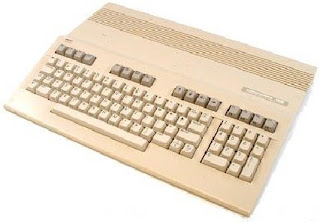
Commodore 128
The last of Commodore's 8-bit machines (the C128) was launched at the Las Vegas Consumer Electronic Show in 1985. It was presented as a competitor to the Apple Macintosh and the IBM PC, but things never really panned out this way.
Thanks to the Z80 chip, not only could you run 2 monitors, you could also select which mode to run the C128 under during boot up. The downside was that the 2 processors could not run concurrently, so it was not a true multiprocessing system.
But let us not focus on any downside, the inclusion of BASIC 2.0 and the C64 KERNELS made C64 compatible mode possible, and it was almost 100% reliable. A multi-mode machine. Clever stuff from CBM.
Modes of operation:
C128 Mode:
While the C64's graphics and sound capabilities were generally considered excellent, the popular home computer was subject to a number of criticisms. The 40-column VIC-II video display while excellent for use with computer games, was often considered inadequate for 'office' applications such as word processing. The lack of a numeric keypad was also an issue with some office suite software.
Commodore BASIC 2.0 that had been incorporated into the C64 was quite limited to serious programmers as it lacked keywords to handle the system's graphical and sound capabilities. These features had to be accessed via cumbersome PEEK and POKE commands or by machine language routines. Also criticized was the lack of a hardware reset button, which was an essential device when developing assembly language routines. The C64's 1541 disk drive was almost universally labelled as unreliable and slower than a Cliff Thorburn 147.
The designers of the C128 managed to rectify most of these 'downsides'. A new chip (the VDC) provided the C128 with an 80 column colour CGA compatible display (also snappily called RGBI for RGB plus Intensity).
The new 8502 CPU was completely backward compatible with the C64's 6510, but could run at double the speed if you so desired. However, the VIC-II chip which controlled the 40-column display could not operate at the faster clock rate, so the 40 column display was not available in 'Fast Mode'. A numeric keypad was also added to the keyboard to placate the officy types.
The C64's rudimentary BASIC 2.0 was replaced with the far more powerful BASIC 7.0, which included keywords designed specifically to take advantage of the machine's capabilities. It also incorporated a sprite editor (very useful when developing arcade games) and machine language monitor. The screen editor was further improved and an all important reset button was added to the system.
Three new disk drives were introduced in conjunction with the C128, the 1570, 1571, and 3.5 inch 1581 drives promising far faster transfer speeds via a new 'burst mode'. Gotta love those technical terms.
The 128KB RAM allowed a higher proportion to be available for BASIC programming. This was due to the new MMU bankswitching chip. This feature made it possible for BASIC program code to be stored separately from variables which greatly enhanced the machine's ability to handle more complex programs.
CP/M Mode:
Unfortunately, the C128 ran CP/M slower than most dedicated CP/M systems, as the Z80 processor could only run at an effective speed of 2 MHz instead of the more common 4–6 MHz. Because it used CP/M 3.0 this versions complexity made it inherently slower than the earlier and more widespread, CP/M 2.2 system. CP/M never mode fully worked on the C128 - which was a bit of a bummer really.
- Holding down the Commodore logo key when the system was booting up
- Like a superhero's mantra, enter the 'GO 64' command in BASIC 7.0 immediate mode
- Boot it with a C64 cartridge plugged in
- By going right through Falkens Maze
Some of the few C64 programs that failed on a C128 ran correctly when the CAPS LOCK key was pressed (or the ASCII/National key on international C128 models). This has to do with the larger built-in I/O port of the C128's CPU. Interesting yet boring at the same time.
The 128D model:
The 128D was the direct successor of the Commodore 128. It had exactly the same characteristics as the C128 apart from its external case which contained the Commodore 1571 floppy disk unit. It did have a more professional look to it, akin to a desktop PC, but also lost some of that well known Commodore appeal.
The C128 sold reasonably well, but never reached anywhere near the popularity of it's predecessor. It was also hampered by the release of 16-Bit machines such as the Amiga and the Atari ST which quicky built a large library of text adventures and classic games.
A very good machine and a worthy one to close out the 8-Bit era. A fine retro computer.
We recommend trying to pick up one of these machines.
Look at computers for sale online or even locally.
If you don't want to get hold of the real hardware then try and download an emulator and
download those classic games. Alternatively you could try and play them online.
NAME: C128 - C128D
MANUFACTURER: Commodore (CBM)
MACHINE TYPE: Home Computer
COUNTRY OF ORIGIN: USA
RELEASE YEAR: 1985
END OF PRODUCTION: Unknown (possibly 1989)
BUILT IN LANGUAGE(S): Basic
KEYBOARD: Complete full stroke keyboard and numeric keypad
CPU: 8502 + Zilog Z80
SPEED: 1/2 mHz (for the 8510), 1.022 MHz (for C64 mode), 2.5 MHz (Z80)
CO-PROCESSOR: SID (sound), VDC & VIC-II (video)
RAM: 128 KB
VRAM: 16 KB
ROM: 48 KB
TEXT MODES: 40 or 80 chars x 25 lines
GRAPHIC MODES: Several although most popular were: 160x200, 320x200, 640x200 COLORS: 16
SOUND: 3 voices / 6 octaves
I/O PORTS: RGB, Video Composite, Joystick (2), Cardridge, Tape, User Port (RS232 compatible), TV, serial
BUILT IN MEDIA: C128D had a 1571 disk-drive OS: C128 mode, C64 mode or CP/M
POWER SUPPLY: C128 had an External PSU, the C128D had a Built-in PSU
PRICE: ?
Retro Computers and classic games




1 comments:
Incorrect statment in there "the Z80 chip made C64 compatible mode possible". This isn't true, the C64 mode uses the 8502 cpu. The Z80 is used in CPM mode.
Post a Comment